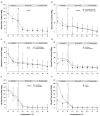Rewarming With Closed Thoracic Lavage Following 3-h CPR at 27°C Failed to Reestablish a Perfusing Rhythm
- PMID: 34658927
- PMCID: PMC8511428
- DOI: 10.3389/fphys.2021.741241
Rewarming With Closed Thoracic Lavage Following 3-h CPR at 27°C Failed to Reestablish a Perfusing Rhythm
Abstract
Introduction: Previously, we showed that the cardiopulmonary resuscitation (CPR) for hypothermic cardiac arrest (HCA) maintained cardiac output (CO) and mean arterial pressure (MAP) to the same reduced level during normothermia (38°C) vs. hypothermia (27°C). In addition, at 27°C, the CPR for 3-h provided global O2 delivery (DO2) to support aerobic metabolism. The present study investigated if rewarming with closed thoracic lavage induces a perfusing rhythm after 3-h continuous CPR at 27°C. Materials and Methods: Eight male pigs were anesthetized, and immersion-cooled. At 27°C, HCA was electrically induced, CPR was started and continued for a 3-h period. Thereafter, the animals were rewarmed by combining closed thoracic lavage and continued CPR. Organ blood flow was measured using microspheres. Results: After cooling with spontaneous circulation to 27°C, MAP and CO were initially reduced by 37 and 58% from baseline, respectively. By 15 min after the onset of CPR, MAP, and CO were further reduced by 58 and 77% from baseline, respectively, which remained unchanged throughout the rest of the 3-h period of CPR. During CPR at 27°C, DO2 and O2 extraction rate (VO2) fell to critically low levels, but the simultaneous small increase in lactate and a modest reduction in pH, indicated the presence of maintained aerobic metabolism. During rewarming with closed thoracic lavage, all animals displayed ventricular fibrillation, but only one animal could be electro-converted to restore a short-lived perfusing rhythm. Rewarming ended in circulatory collapse in all the animals at 38°C. Conclusion: The CPR for 3-h at 27°C managed to sustain lower levels of CO and MAP sufficient to support global DO2. Rewarming accidental hypothermia patients following prolonged CPR for HCA with closed thoracic lavage is not an alternative to rewarming by extra-corporeal life support as these patients are often in need of massive cardio-pulmonary support during as well as after rewarming.
Keywords: accidental hypothermia; cardiopulmonary resuscitation; hypothermic cardiac arrest; organ blood flow; reperfusion.
Copyright © 2021 Nivfors, Mohyuddin, Schanche, Nilsen, Valkov, Kondratiev, Sieck and Tveita.
Conflict of interest statement
The authors declare that the research was conducted in the absence of any commercial or financial relationships that could be construed as a potential conflict of interest.
Figures




Similar articles
-
Effects of rewarming with extracorporeal membrane oxygenation to restore oxygen transport and organ blood flow after hypothermic cardiac arrest in a porcine model.Sci Rep. 2021 Sep 23;11(1):18918. doi: 10.1038/s41598-021-98044-2. Sci Rep. 2021. PMID: 34556695 Free PMC article.
-
Study of the Effects of 3 h of Continuous Cardiopulmonary Resuscitation at 27°C on Global Oxygen Transport and Organ Blood Flow.Front Physiol. 2020 Apr 16;11:213. doi: 10.3389/fphys.2020.00213. eCollection 2020. Front Physiol. 2020. PMID: 32372965 Free PMC article.
-
Autoregulation of Cerebral Blood Flow During 3-h Continuous Cardiopulmonary Resuscitation at 27°C.Front Physiol. 2022 Jun 9;13:925292. doi: 10.3389/fphys.2022.925292. eCollection 2022. Front Physiol. 2022. PMID: 35755426 Free PMC article.
-
Thoracic lavage in accidental hypothermia with cardiac arrest--report of a case and review of the literature.Resuscitation. 2005 Jul;66(1):99-104. doi: 10.1016/j.resuscitation.2004.12.024. Epub 2005 Apr 18. Resuscitation. 2005. PMID: 15993735 Review.
-
Physiological Changes in Subjects Exposed to Accidental Hypothermia: An Update.Front Med (Lausanne). 2022 Feb 23;9:824395. doi: 10.3389/fmed.2022.824395. eCollection 2022. Front Med (Lausanne). 2022. PMID: 35280892 Free PMC article. Review.
References
-
- Aufderheide T. P., Alexander C., Lick C., Myers B., Romig L., Vartanian L., et al. . (2008). From laboratory science to six emergency medical services systems: new understanding of the physiology of cardiopulmonary resuscitation increases survival rates after cardiac arrest. Crit. Care Med. 36(11 Suppl), S397–S404. 10.1097/CCM.0b013e31818a7e56 - DOI - PMC - PubMed
-
- Barr G. L., Halvorsen L. O., Donovan A. J. (1988). Correction of hypothermia by continuous pleural perfusion. Surgery 103, 553–557. - PubMed
LinkOut - more resources
Full Text Sources

